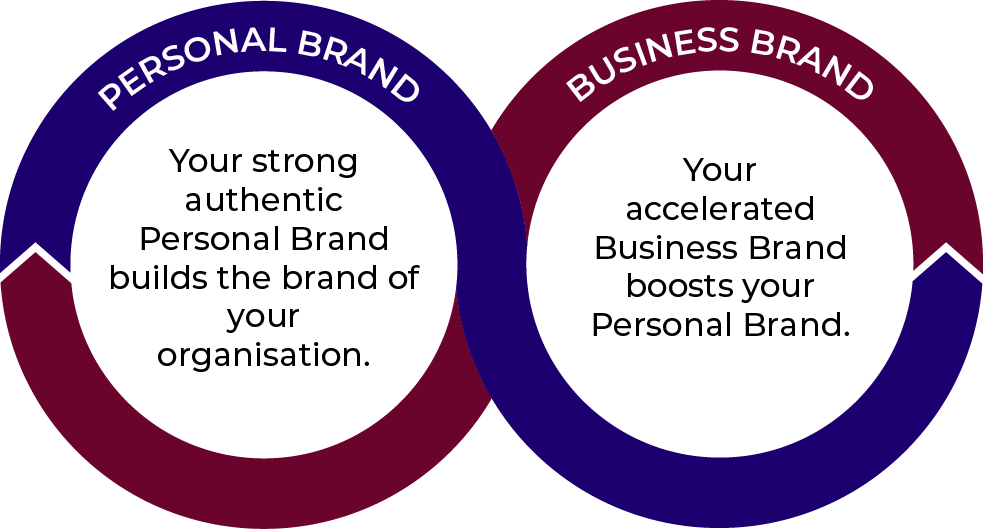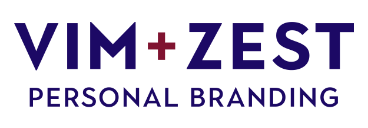Personal Branding – The Driver of Your Career Success
“First impressions count. A clear and authentic Personal Brand is what builds your strong reputation. It’s the public perception that’s the sum total of who you are, why you do what you do, what you stand for and what makes you different and unique.
Online visibility with a clear and congruent Personal Brand is what attracts the best opportunities to you.” – Trudy Johnston, Founder of Vim + Zest Personal Branding
A Personal Brand is your unique profile, reputation and image. It’s how your audience comes to know of you, what they perceive you stand for and what they think you do before they meet you. It’s particular to you and identifiable only to you. Personal Branding anchors your reputation online, in the media and on social media. When you have a strong Personal Brand, you become the authority and thought leader in your field.
You only get one chance to make a strong and memorable first impression. Make those valuable 2-3 seconds count.
Online Visibility with a Strong Personal Brand Attracts Opportunities
When your reputation precedes you, because you have a compelling Personal Brand, you’re able to develop networks that open and create your success pathways – whether that be invitations to join Boards, an upgraded CEO position, new entrepreneurship opportunities or being exactly where headhunters and recruiters are looking for talent.
Clear Communication Helps Headhunters Find & Choose You
With a strong Personal Brand, you become a leader in the mind of your audience. This is why an audience will choose you – over others.
Consider this, an employer is considering two candidates with comparable experience and skills. One has a strong online presence and frequently weighs in on industry topics through social media, blogs and LinkedIn articles.
Guess which candidate gets the job?
Did you know 80% of recruiters consider Personal Branding important when evaluating job candidates?
Personal Branding Starts with Values That Build Relationships
Your Personal Brand articulates your values. Your audience is subconsciously and consciously looking to see if there is a shared pool of meaning and a commonality of values in a leader they admire and aspire to be like. They seek to engage with and follow those leaders who embody and embrace likeminded values.
Building a Personal Brand Strategy
Your Personal Branding strategy shows the pathway to building your authoritative leadership and becoming a subject matter expert, poised to share your expertise. It includes the best communication style to adopt when you’re fearlessly opinionated about what’s relevant in your field, and what content you should be sharing about what’s new and trending in your area.
This makes you the leader your audience seeks out. And it all starts with getting your Personal Brand right.
“A brand is the set of expectations, memories, stories and relationships that, taken together, account for a consumer’s decision to choose one product or service over another.” – Seth Godin.
Branding is the creation of a name, symbol and design that is easily identifiable to a company, set of products, services or individual. It is the very foundation of all your communications, marketing, PR and social media – whether the branding is product-based, service-oriented or person-centric.
The purpose of branding is to build a crucial relationship with your audience. The magic happens when the core values and aspirations of your audience align with yours.
Personal Branding Creates 'Pull Power'
In the same way that consumer brands have a ‘pull’ power, so do Personal Brands. Consumer brands and Personal Brands share many common attributes, but the starting point in every instance is always with the audience.
Intimately knowing your audience is essential. If you want to build influence, you must understand your audience’s value sets, challenges, motivations and buying behaviours, so you can connect with them. They will be far more receptive to your brand when you are authentic and genuine because they seek to match their value sets with yours.
“The foundations of consumer and Personal Branding come down to the same thing: establishing and maintaining trust with audiences. Building relationships.” – Trudy Johnston, Founder of Vim + Zest Personal Branding
Personal Branding Must Be Authentic
Today’s audiences are digital and social natives, and highly discerning. They are bombarded and overwhelmed with advertising, media and social media messages every day. Achieving cut through in the overcrowded online space is the single biggest challenge for every brand.
If you want to attract and retain a loyal audience, start with demonstrating integrity, authenticity and shared values.
Gravitas: The Right Mix of Authority and Empathy
Have you ever met someone who has that ability to just own the room? This same effect can be achieved through an online Personal Brand. It’s called gravitas. Gravitas is the combination of authority and empathy.
Authority is achieved through thought leadership, discussing important issues and future trends of your industry. Empathy is achieved by truly understanding your audience’s challenge and speaking to them, ensuring your audience realises you know how they feel.
Our work in Personal Branding allows you to master essential leadership communication skills, enabling you to confidently and authentically tell your story with gravitas.
Trust – The Essential Brand Building Block
Establishing trust through shared values is the fundamental building block to growing a successful Personal Brand. Trust is the building block of relationships – on and offline.
An article by the Centre for Creative Leadership defines trust as ‘uncompromised by doubt’. Doubt stops your audience from finding out more about you, reaching out to work with you or making a purchase decision.
Your Personal Brand is online, 24 hours a day, working to build trust with your target audiences.
Personal Branding Requires Vulnerability
We recognise trust as being when someone is consistent, admits their mistakes, gives and receives constructive feedback and is open to sharing information. In order for us to trust, a person must have the capacity to hold space for all that – and more. They must be entirely congruent.
There is a science to trust – oxytocin, a hormone that makes you feel good, is at the heart. Making people feel good means they’re more likely to trust you. Trust is also born when we show up authentically.
Personal Branding Sometimes Requires Confrontation
It’s not enough to be calm, cheerful, well-groomed and sprout the ‘talking points’ your publicist has given you. This often looks and feels one-dimensional. What people really crave is your honest actions and your insightful reaction. Sometimes this involves raw vulnerability.
Your peers, employees and clients will follow someone they believe will take them to a new and brighter future. Even if they don’t necessarily know what that looks like just yet.
“In order to keep your trust relations on an even keel, and the playing field level, you have to be willing not only to take chances by initially trusting a bit (signalling a willingness to cooperate) but also to retaliate strongly, quickly, and proportionately.”
– Solotar Harvard Business Review
What Self-Branding Is Not
Good Personal Branding is not vanity metrics or a superficial slice of clever self-promotion. We’ve all seen the inevitable cracks that appear in an over-manufactured persona and how this results in a loss of trust.

Building Your Personal Brand to Optimise the Brand Spiral
Personal Branding is so potent and so valuable because it builds The Brand Spiral. This is exactly what makes it one of the smartest – and most commercially lucrative – marketing strategies available today.
The Brand Spiral is a win-win loop where business brands are amplified through strong Personal Brands and, in turn, Personal Brands are strengthened through strong business brands. The signal is not only amplified on both sides, it’s an ever-growing, upwardly moving, win-win movement.
Did you know 82% of customers trust a company when their senior management members are active on social media?
What Headhunters and Recruiters Look For
Boards of Directors, headhunters and recruiters understand the impact of The Brand Spiral dynamic. This is what drives them to pursue leaders with strong Personal Brands and reputations. They understand the ‘pull’ power of a charismatic reputation and dynamic, positive brand growth.
For example, Sir Richard Branson and the Virgin Group exemplify how effective The Brand Spiral can be. Both Branson and his group of Virgin companies radiate a reputation for being smart, bold, entrepreneurial and fun. People trust Virgin because they like Branson. The brand values are one and the same.
In his book Start with Why, Simon Sinek applies the same approach to Steve Jobs and Apple. He says, “the personalities of Jobs and Apple are exactly the same. In fact, the personalities of all those who are viscerally drawn to Apple are similar. There is no difference between an Apple customer and an Apple employee.”
Smarter Marketing Yields Better Commercialisation Opportunities
Commercial opportunities are amplified when there is a strong leader influencing and persuading brand choice in the market.
Effective Personal Branding offers multiple opportunities to strategically enter and build new markets through profiling the leader of a company or organisation in the first instance, then following with launching the product or service.
The Downward Brand Spiral
Whatever you do, say or sell is a representation of your brand. As well as an upward spiral movement, the Brand Spiral can work in reverse – in a downward motion. It’s been widely documented that the share prices of companies fall when the CEO or leader has been disgraced. You don’t want to be remembered for your ‘missteps’.
Authenticity is the only way. Your customers and clients feel it. Employee engagement relies on it. Your business brand could be damaged if the pinnacle of the brand pyramid is unstable, cracked or not representative of its core values.
How to Build a Personal Brand
Your WHY Is Key to Successful Personal Branding.
“People don’t buy what you do, they buy why you do it. And what you do simply proves what you believe.” – Simon Sink, bestselling author and TED talk sensation
As Simon Sinek demonstrates, your ‘WHY’ directly articulates your value set. Your values are the building blocks of trust. They directly create the basis for a ‘shared pool of meaning’ with your audience. Therefore, your ‘WHY’ is at the very epicentre of your Personal Brand, not your ‘what’. It’s your first building block.
So, discovering, or re-discovering your WHY is the essential first step. It’s critical for you to know it inside and out.
When building yourself as a brand, you need to break down the elements of ‘who you are’ by asking the following questions:
- What’s important to you?
- Why do you do what you do?
- Who do you do it for?
- How do you operate when you’re in flow?
Additionally, identifying your blind spots – especially the blind spot of ‘what’s truly great about you’ – gives you the clarity to then go and amplify these areas.
As your self-awareness expands, so will any business or personal transactions you engage in. One is naturally affected by the other. That’s The Brand Spiral at play.
Storytelling Using the Hero's Journey
American mythological researcher, Joseph Campbell, is renowned for a book he wrote about the common patterns in hero myths and stories from around the world. The book, The Hero with a Thousand Faces, details years of research that allows the author to identify various different stages of the hero’s quest, and the hero’s act of making meaning of their life.
If you consider all of your favourite books and movies, we would wager that they closely align with the stages of Campbell’s Hero’s Journey.
We use these stages in a practical, step by step methodology that allows leaders to confidently build their storytelling abilities. Storytelling allows us to speak about ourselves in a way that feels natural and allows us to speak to the emotions of our audience.
When an audience creates an emotional connection, they build trust.
Through this methodology we define key Personal Branding content such as content pillars, key messages and brand value statements.
Personal Branding Statement
Knowing your WHY enables you to create your Personal Branding Statement. This is a short, catchy and memorable distillation of who you are, your WHY, what you do and who you do it for. It’s more than an ‘Elevator Statement’ – think of it as a ‘mini power story’.
Personal Logo and Brand Photography
Visual storytelling is powerful because it’s what makes you stand out. A strong and unique visual signature is a key ingredient of your Personal Brand. The creation of a personal logo with a brand colour palette is the second building block of your Personal Brand.
Advertisers have known for years that buyers’ motivations are emotion-driven in the first instance, and then rationalised soon after. We buy with our eyes. A strong visual identity is a core component of the attraction.
“The image you want to project and reputation you want to build has many integrated aspects that tells the Brand Story of you – through content (text, visual, video and audio), visual branding, social media and styling – with search metrics attributed to each.” – Trudy Johnston, Founder of Vim + Zest Personal Branding
Personal Branding Logo: Recognition and Memorability
A Personal Brand with an attractive and consistent visual style builds recognition and presence. It creates authority and establishes your leadership credentials.
After creating your logo and colour palette, the next step in building your brand includes planning, designing and styling your photography, business card, email signature, social media profiles (especially LinkedIn), building your website, and defining your wardrobe styling.
Together, these elements create your signature style that makes your brand instantly recognisable – and most importantly – memorable.
Personal Branding Photography
High quality professional photographic images of you are the third building block of your Personal Brand. First impressions really count – your images tell the story of you so ensure it’s the right story you’re communicating! Imagery strongly impacts buying decisions. So good photography often boosts the bottom line of your business.
It’s important to ensure your photos are well styled so they convey your desired image and message. They will be used extensively in biographies, on social media, in websites, job applications, e-signatures, brochures and more, so they are an essential foundational element.
The best professional stylists create a signature style that bridges your current aesthetic and where you aspire to be. In that way your new style is authentic to you, which elevates your confidence. Confidence can be seen through images and in person.
Your Personal Brand Website
What’s the key networking tool that builds awareness and credibility? Your Personal Brand website! It’s the home of your authoritative content and a vital place where your Personal Brand shines and your audience can meet you, before they meet you.
Ensure that (where possible) your domain is your name (e.g. johnsmith.com), your website reflects your chosen design and signature style, your content is SEO optimised with keywords, the architecture is easy to navigate, the UX (user experience) easy to follow and all metadata is included to build search rankings.
Content Is King: Building Your Authority Position
Demonstrate your authority position through the content you produce, share and comment on. Your strategic Personal Branding Content Strategy is a 12-month plan devised to build awareness and engagement, so you reach your Personal Branding goals.
Your content should be based on what your audience is searching for on Google, sharing on social, trending topics in your sector and your subject matter expertise.
Creating Awareness and Engagement Through Social
Once your Personal Brand has been created and your foundations are in place, it’s time to build awareness, amplify your brand, grow your audience on social and drive traffic to your website. LinkedIn is the most important B2B (business to business) platform and the primary outreach component of your Personal Brand social media strategy.
Update your LinkedIn profile to speak to where you aspire to be and how your unique skills allow you to succeed.
Networking through LinkedIn and actively promoting your content builds your network, which in turn creates new opportunities to promote any speaking engagements or media article placements you have – or are seeking. Depending on your target market and business goals, Facebook and Instagram could be relevant to build awareness and engagement.
Measuring Performance with KPIs for Web and Social
As you build your Personal Brand, data metrics are essential in measuring performance and optimising your profile. Data also gives you contextually relevant insights – so you can track your progress in relation to key competitors. This allows you to identify any gaps in your performance and reveals the best opportunities.
Your Personal Brand Strategy should have a set of Key Performance Indicators (KPIs): the metrics that show how well you are tracking in relation to your goals. Strong, accurate data shows you how to activate and accelerate your business and ensure your strategy is working. Use your KPIs to measure your successes, amplify them and refine your approach.
You can measure the performance of your Personal Brand through website traffic (use Google Analytics) and the engagement and performance metrics on social channels.
Climb Over the Imposter Syndrome Wall
So if Personal Branding is so incredibly powerful in attracting audiences, building trust and creating opportunities, why aren’t more people taking advantage of it?
While through my career we’ve heard countless excuses, they all stem from the same foundation: Imposter Syndrome.
Imposter Syndrome can be complex and manifest itself in different ways. Have you ever experienced the following:
- An inability to accept successes – ‘I just got lucky’
- A feeling that you’ll be ‘found out’ – ‘they’ll realise that I don’t have enough qualifications or experience to be here’
The simple truth remains that over 95% of the leaders and celebrities that we have worked with over a 25 year period have Imposter Syndrome. So if you’re experiencing Imposter Syndrome you’ve in good company!
Simon Sinek’s strategy to overcome Imposter Syndrome is to understand that he has ‘already been vetted.’ If he is standing backstage watching a compelling speaker that he’s about to follow and feeling Imposter Syndrome, he tells himself that there are a number of people organising this event and throughout his career that had to decide that he was good enough to be at that event, to give that audience something of value.
Australian billionaire business magnate Mike Cannon-Brookes approaches Imposter Syndrome from a place of gratitude. There have been countless moments in his career that he could have frozen due to fear and let thoughts of ‘what am I doing here?’ get the better of him. Instead he chose to think, ‘I’m so lucky to be here’ and build a positive mindset that propelled him forward into action.
When considering building a Personal Brand, Imposter Syndrome stops leaders from posting on social media, updating LinkedIn profiles and building a Personal Branding website.
Our Personal Branding work is a unique combination of strategic branding and marketing, and coaching. The physical act of developing your Personal Brand helps address the symptoms of Imposter Syndrome and proceed to positive action.
Conclusion: Personal Branding for Fast-Track Growth
Creating and implementing a Personal Branding strategy is the best way to raise awareness of your public presence, control your image and build your reputation. It’s the ideal way that your peers, headhunters and recruiters know you before they meet you.
Personal Branding is a proven fast-track that grows your career and entrepreneurial journey.
When you’ve taken control of your profile and image – and decided how you wish to be perceived in the world – you’ve set the stage. Devising your Personal Brand strategy also goes a long way to becoming the insurance you need against misrepresentation and potential brand damage.
It’s essential to establish your Personal Branding foundations with trust and authenticity. When you see yourself in the context of your market, know what’s trending in your arena, and create content that speaks to that, you’re well on your way to becoming a leader in the minds of your audience.
In anybody’s language, that’s what Personal Branding is designed to do: build your leadership excellence.
Boards of Directors and Executive Recruiters understand the value of leaders with strong Personal Brands, and the important synergy – not to mention the commercial returns – that The Brand Spiral creates.
Personal Branding yields exponential and long-lasting results. This is why Personal Branding is so potent.
Here are some Personal Branding Examples of Successful Entrepreneurs to inspire you as your start your Personal Branding journey.
We’ll help you create a strategic Personal Branding plan to grow your business or accelerate your career. See our Personal Branding packages.
Vim + Zest Personal Branding is a specialist Branding and Marketing agency for people and organisations that matter. We help leaders to create impact to build a better world.
1 & 2 Pope, Lauren (2023) 75 Branding Statistics for 2024: Top Insights and Trends. LearnG2
i Barrett, S. (2018, October 1). SALES, STRATEGY ‘Social selling’: Why Personal Branding is a priceless asset to any business. Retrieved March 27, 2019, from SmartCompany: https://www.smartcompany.com.au/marketing/sales/social-selling-personal-branding-priceless-asset-business/
ii Godin, S. (2009, December 13). Define: Brand. Retrieved March 27, 2019, from Seth’s Blog: https://seths.blog/2009/12/define-brand/
iii Sinek, S. (2017). Find Your Why. New York, NY: Portfolio/ Penguin.
iv Solotar, J. (2014, July 29). The Former CEO of Ogilvy & Mather on Personal Branding. Retrieved March 27, 2019, from Harvard Business Review: https://hbr.org/2014/07/the-former-ceo-of-ogilvy-mather-on-personal-branding





